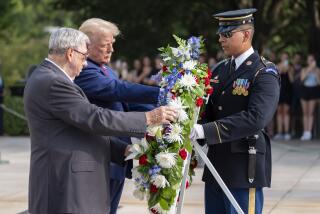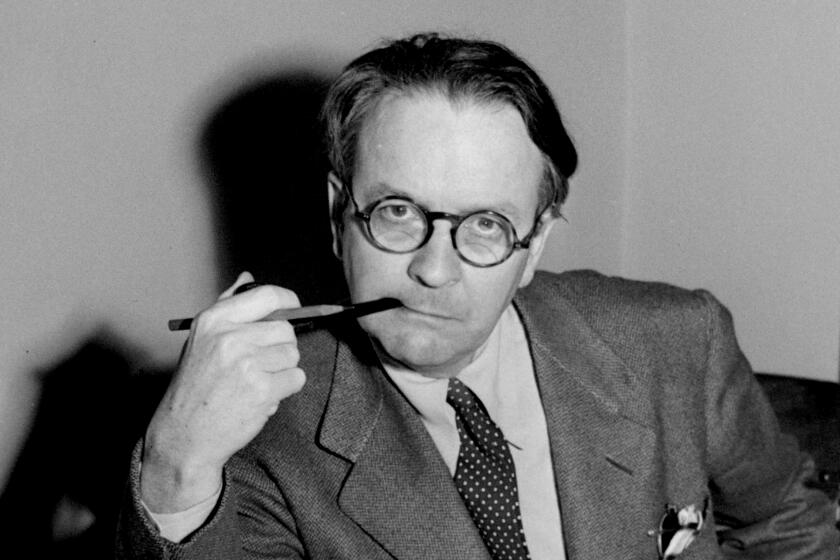Cemetery Was Not an End, but a Beginning
- Share via
Among Los Angeles’ legion of unusual celebrities, none is more novel than Hubert Lewright Eaton, who stumbled onto every businessman’s dream: a steady stream of customers incapable of complaint.
As “the builder” of Forest Lawn cemetery, Eaton created what may be one of the nation’s most famous permanent addresses. In the process, he revolutionized the industry by transforming a tiny graveyard into a 300-acre spiritual haven for the living.
That, of course, required eliminating tombstones, recreating famous churches, acquiring a vast collection of fine art reproductions--from Michelangelo’s “David” to Leonardo da Vinci’s “Last Supper”--and, not incidentally, elevating death to big business.
Eaton’s imagination brimmed with ideas elevating and bizarre: the first Easter sunrise service, one-stop funeral shopping, burial insurance and the “before need” concept.
In fact, Eaton’s local influence was so pervasive that he inspired two bemused British expatriates’ novels: Aldous Huxley’s “After Many a Summer Dies the Swan” in 1939 and Evelyn Waugh’s “The Loved One” in 1948. Born in Missouri in 1881, Eaton lived only a few blocks from a schoolmate who later would become president of the United States: Harry S. Truman. Eaton majored in science at William Jewell College in Liberty, Mo.
He subsequently punched cattle and assayed copper and quelled riots in Mexico. He briefly struck it rich in the Nevada silver fields. But when the silver streak disappeared, Eaton found himself deeply in debt and in need of a job.
By 1912, he had ended up in Tropico--now Glendale--selling plots in a dreary, 6-year-old, 12-acre cemetery called Forest Lawn. It was a disaster, a financial sinkhole that needed not just a face lift but also a miracle.
While the Los Angeles Chamber of Commerce was busy trying to sell its climate to winter-weary Easterners, Eaton began promoting his “before need” plan to newcomers in town to warm their blood. Within a year he had increased sales by 250%, and he soon bought an interest in the cemetery.
On New Year’s Day 1917, he stood on a hilltop overlooking the cemetery, which had grown to 55 acres. It was drab and uninviting, but Eaton envisioned narrow, winding roads meandering through lush green grass and overhanging trees.
He would offer cradle-to-grave service with baptisms, weddings and funerals. Instead of a city charter it would have its builder’s creed, and instead of a city council it would have a board of regents.
“The cemeteries of today are wrong, because they depict an end, not a beginning. . . . I shall endeavor to build Forest Lawn as different, as unlike other cemeteries as sunshine is unlike darkness, as eternal life is unlike death.” Eaton’s thoughts would later be carved into a two-story slab of stone.
When he finally figured out how to get rid of the devil grass, he presented his “memorial park” theme to the board of regents. The toughest shell to crack was that of banker-millionaire Motley Flint, founder of Flintridge and brother of a U.S. senator.
Flint eventually backed Eaton, but he wound up shot to death in a Los Angeles courtroom with $63,000 in his pocket--all part of the notorious Julian Petroleum stock swindle. He was, of course, buried at Forest Lawn.
So, too, was another local celebrity, L. Frank Baum, author of “The Wizard of Oz.”
By 1923, Eaton had raised profits and his cemetery’s aesthetic profile by offering a 10% discount on grave sites to purchasers willing to forfeit “monument privileges” in favor of a ground-level bronze plaque.
Part of the profit went into amassing what would become the largest collection of marble statuary in the nation, including exact reproductions of Michelangelo’s greatest works--”David,” “Moses” and “La Pieta”--along with Leonardo da Vinci’s immortal “Last Supper,” re-created in stained glass, and two of the world’s largest paintings, “The Crucifixion” and “The Resurrection.”
That same year, the first wedding was held at the Little Church of the Flowers, dedicated five years earlier. Thousands more weddings would follow at two more quaint chapels: the Church of the Recessional and the Wee Kirk o’ the Heather, a reproduction of the small 14th century Scottish church where Annie Laurie, the sweetheart of poet Robert Burns, worshiped.
Eight stained-glass windows along the south side of the chapel tell the bittersweet story of her love for a rival clansman whom her father forbade her to marry. A nearby Scottish wishing chair is built of stones from the original kirk at Glencairn, Scotland.
Perhaps the best-known couple to marry at the Wee Kirk were Ronald Reagan and Jane Wyman.
In 1932, intent on burying the competition as well as his patrons, Eaton began refusing to give undertakers a kickback for referring business his way and decided to build his own mortuary.
After a year of boycotts, death threats, legal and legislative wrangling and nuisance suits, he completed the $150,000 embalming building, pleasantly disguised as George Washington’s Mount Vernon home.
*
*
On New Year’s Day 1934, nearly two decades after Eaton’s dream began taking form, Forest Lawn finally had everything in one place: mortuary, cemetery, church and flower shop. Mourning--which is to say, paying--customers no longer had to drive through city streets and freeways at 15 mph under the stares of curious onlookers on their way to a loved one’s grave.
In the 1940s, Waugh pored over his personal copy of “Embalming Techniques,” autographed by Eaton, who may have been lulled by years of working with the dead into forgetting how dangerous a live writer can be.
The English author poked fun at Forest Lawn in “The Loved One,” caricaturing it as a kind of amusement park. Statues are wired for sound, souvenir shops sell graveyard postcards and spoons, and Abraham Lincoln occasionally roams the grounds in stovepipe hat. At Easter, none other than Jesus Christ makes a cameo, while cemetery sections boast such names as Lullabyland and Inspiration Slope.
Eaton wasn’t amused with Waugh’s biting satire, but it didn’t stop him from sponsoring a writing award program through local universities.
Before joining his customers in eternity in 1966, Eaton leveraged his vision into a five-cemetery chain.
Today, Forest Lawn--Glendale, Hollywood Hills, Cypress, Covina Hills and Long Beach--has an unrivaled celebrity clientele and is second only to Arlington National Cemetery as a cemetery tourist attraction.
More to Read
Sign up for our Book Club newsletter
Get the latest news, events and more from the Los Angeles Times Book Club, and help us get L.A. reading and talking.
You may occasionally receive promotional content from the Los Angeles Times.









